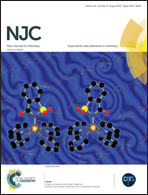Controllable wettability of micro- and nano-dendritic structures formed on aluminum substrates†
Abstract
A superhydrophilic surface with a static water contact angle of 4° ± 2° via two-step immersion process and a superhydrophobic surface with a static water contact angle of 169° ± 2° and a sliding angle of almost 0° via successive thermal treatment have been successfully fabricated on aluminum substrates. Surface morphologies and chemical compositions were investigated using field emission scanning electron microscopy, X-ray powder diffraction and X-ray photoelectron spectroscopy, and the formation mechanism was also analyzed. The thermal treatment, which causes the generation of oxides and the appearance of nano-sized particles, is very important for the surface characteristic transformation from superhydrophilicity to superhydrophobicity. The effects of various experimental parameters on wettability, corrosion resistance, anti-icing and deicing properties, stability and large-area preparation were also studied. The corrosion rate of the as-prepared superhydrophobic surface decreases by about 57.6 times compared with that of the untreated aluminum surface and about 34.8 times compared with that of the pure copper surface. These excellent properties of the superhydrophobic surface may be favorable for its potential applications and industrialization.



 Please wait while we load your content...
Please wait while we load your content...